I returned to the boat late to find Alan had already turned in, so it wasn't until later in the morning when I got an update of the previous days events.
He reported that after a long lie in, and chats with other crews, the wind had got up from astern, and had succeeded in forcing the boat against the quay. Fearing damage from further collisions, he wisely tried to tighten the stern rope moored to a buoy. We had already got this as tight as we could by hand, so Alan had attempted to tighten it further by one of the stern winches, only to succeed in wrenching the winch out of the deck! He had to resort back to hand tightening the rope, and spent the next few hours bedding the winch back onto the deck.
After breakfast and shower, I walked into town to get provisions while Alan topped up the water tank. This operation was only possible with the harbour master being present. This was a problem since we normally liked to let the water run for a couple of minutes to flush out any contamination in the hose pipe, but the harbour master's presence prevented that. Perhaps he hung around because he felt that folk would run off with his 100m long rubber hose pipe.
I bought provisions in the market square, which was alive with colours and smells, and swelled to capacity with people. Similar to Riga, strawberries and cherries were in season; they were everywhere. What was noticeable was a lack of other fruit such as apples, bananas etc, and some vegetables such as carrots or mushrooms. The policy seemed to be only sell what was in season.
When I returned, Alan had decided to move on, and had plotted a course to Liepaja further down the coast, despite the conflicting reports we were getting about wind speed and direction. We were sailing the Baltic in the unconventional clockwise direction due to the necessity of having to reach St Petersburg within the visa window of opportunity. The more popular anti-clockwise direction apparently made better use of the winds.
We slid out of port in a thick sea fog and headed out along a channel into the open sea, with hardly a breath of wind.
Being thirsty, I poured myself a glass of water. Yuck! It tasted foul; I could almost chew on the rubber taste. The Ventspils rubber pipe treatment was a nasty torture indeed. Alan tried a cup of tea later, and he too spat it out. The water tank was immediately emptied into the sea.
The fog never abated and the wind speed and direction was opposite to that predicted. We motored, then tried sailing to no avail, and then motored with the sound of thunder in our ears.
12th June
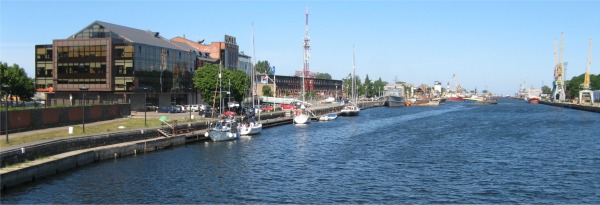 Tirdzniecibas Kanals - Kiitaja on the Left |
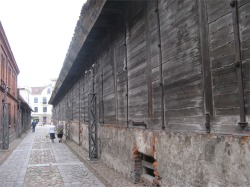 Jana Street |
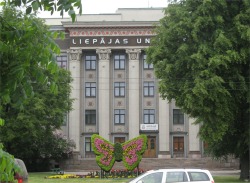 Liepaja University in Rose Square |
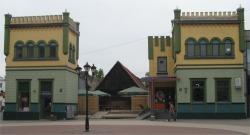 Butchery in Rose Square |
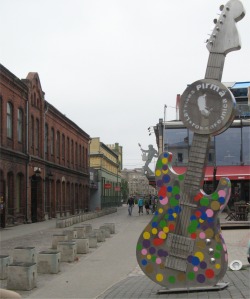 Latvian Musician's Walk of Fame |
A short distance further on lay the Holy trinity Cathedral, built 1742-58 for a German congregation. Both the interior and exterior of the cathedral were late Baroque with elements of Classicism. It boasted the biggest mechanical organ in the world, with 131 registers, 4 manuals and more than 7,000 pipes. This meant nothing to me but it certainly impressed Alan.
Nearby was the heart of the city, Rose Square which featured 500 roses - obviously. The square led off to the Latvian Musician's Walk of Fame, featuring 35 bronze plaques commemorating musicians; I guess Liepaja's answer to the Los Angeles Walk of Fame.
Carrying on with my Hansel and Gretel impression, and following the notes, I came across one of the oldest 17th century buildings in Liepaja, a wooden house with rope caulking and small paned windows, known as the House of Tsar Peter I. In 1697, Russian Tsar Peter I stayed in this building, which was a hotel at the time, allegedly because it was the only one with an inside toilet. He was traveling around Europe at the time incognito, as he often did.
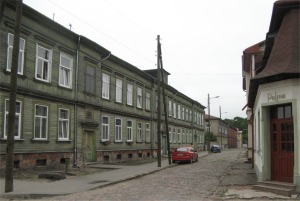 |
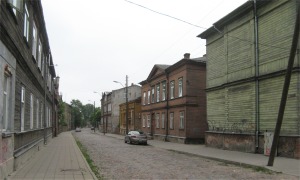 Old Cobbled Backstreets |
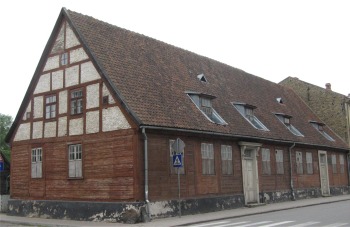 House of Tsar Peter I |
A stone throw away was St Joseph's Catholic Cathedral. I took time out to look inside. It was very ornate like a lot of Orthodox churches, slightly dim, but beautiful, with most walls and ceilings painted with pale pastel images. What struck me about the building was that similar to the Holy Trinity Cathedral, there was a lot of "greenery" inside; indeed pots containing small birch trees lined the aisle, and a large container with hanging flowers dangled from the ceiling. Of note was a side chapel which contained a model ship suspended in it. Ship captains used to hang models of their ships in churches before going to sea, so that God would protect them from storms. Again, when they returned safely, they served to give thanks for their return.
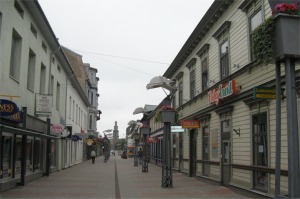 Tirgonu Street |
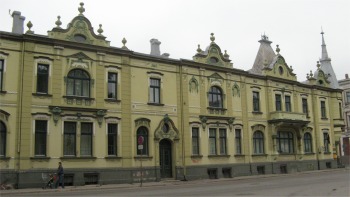 Typical Kurmajas Prospekts Building |
By now it was raining, so I made my way back to the boat through ramshackle backstreets belonging to a long lost era.
Alan had managed to assemble some reports on wind forecasts, it had been a painful process, eventually relying on Vodaphone mobile connectivity. The nearby hotel was meant to offer good Wifi connectivity, but when he inquired at the desk, they said he could use it without any problems, and they even gave him a free glass of red wine to go with it. Alas, the Wifi connectivity was non-existent. However, the entertainment was good. A chap had turned up wearing nothing but a night gown, and proceeded to fall asleep in the lobby. The manager and three policemen had him surrounded, and on arousing him out of his drunken stupor, found that he could not remember who he was or how he came to be there.
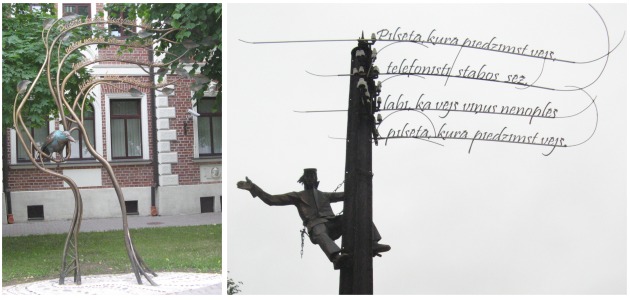 Kurmajas Prospekts Sculptures |
We wandered back to the canal and found a restaurant nearby. The food was good, but even better was a waitress who had a good command of English. It transpired that she was a music student specialising in the flute, and moreover she played for the Liepaja Symphony Orchestra. Alan was enthralled and went into raptures about the recorder and oboe he had played in the past, what music he enjoyed playing, and what did she play etc. Apparently she had been playing opera music the night before; not Alan's most favourite music.
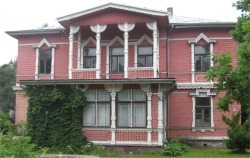 Upmarket House Near the Beach |
13th June
We were greeted by a bright, cheery morning and another English boat arriving. The crew had just experienced a bumpy trip up, and were on their way to Riga, from where they would fly home and return back in two weeks.
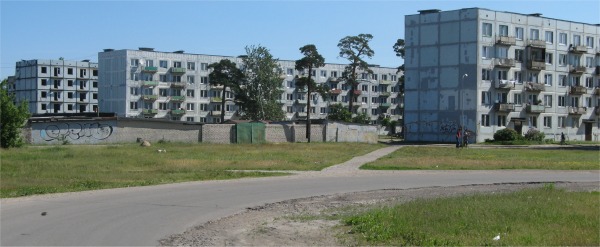 Flats in Former Russian Enclave |
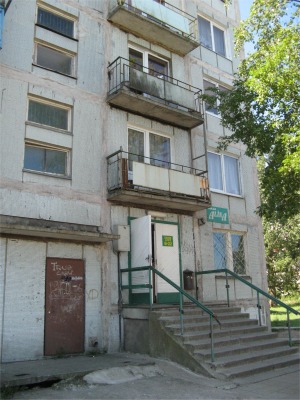 A Grim Shop in the Enclave |
Our reason for visiting the area was not to admire the decay of Soviet military architecture, but to visit the St Nicholas Orthodox Maritime Cathedral. Just as Ely Cathedral stood high and proud of its surroundings in the English Fens, this magnificent building dominated the skyline in Karosta.
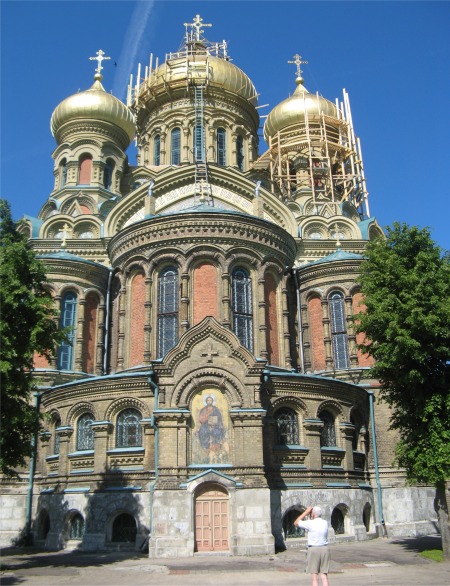 St Nicholas Orthodox Maritime Cathedral |
Today, we found the entrance to the cathedral strewn with grass, as was the interior floor (for what reason I'll never know). Some form of service was taking place inside with a congregation consisting mainly of old women, one man and two boys. Unfortunately, we were prevented from entering by an ancient granny, who conveyed in sign language that we were wearing shorts. I didn't realise my legs were so offensive to her. However, I could make out a brightly coloured painting on the curved ceiling above the alter, which must have been spectacular close up.
We left this jeweled oasis buried within the decaying desert of the Soviet era, and headed back to Liepaja. Once back, I disappeared off to buy fresh food whilst Alan went off to inspect the great organ in the Holy Trinity Cathedral. Although he did manage to get a closer look than I did, he was disappointed that a lot of it was locked up so that he could not inspect the inner workings.
After a quick lunch we cast off our lines and headed out to sea for a sail down to Klaipeda in Lithuania. The sail was excellent to start with, but as was often the case, the wind shifted around to an unfavourable direction and dropped considerably. As we approached the border between Latvia and Lithuania, we were called up by the Lithuanian border control, requesting all our details and where we were heading to. A short while later the Lithuanian coast guard went through the same ritual. Finally we resorted to motoring the last stage of the journey.
